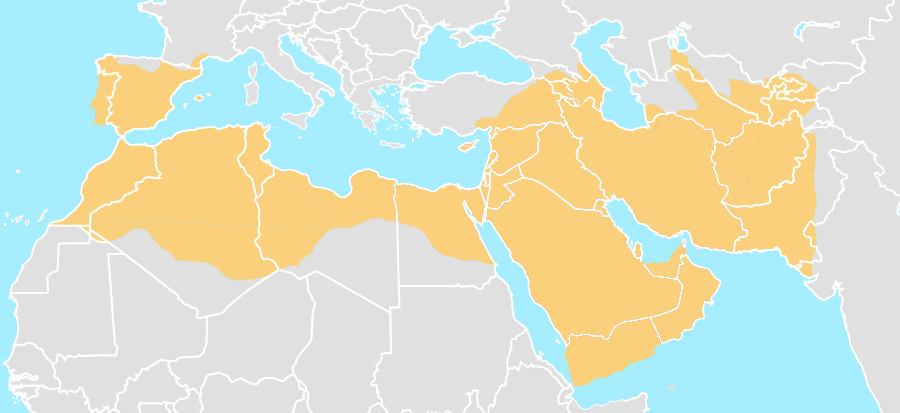Events that lead to the birth of Portugal!
Hello fellow Steemians!
I hope to share with you the historic events that lead to the creation of Portugal as a country. In this post I will try to cover the events that prelude the birth of the country between the years 711 - 868 AD.
I hope you have a great day and that you enjoy reading my post!
Since the late 500’s, following the defeat of the Alans and the Suebi, the Iberian peninsula (Portugal, Spain, Andorra and Gibraltar) had been unified under christian Visigothic rule.
Some 150 years later in the year 711 AD an invasion force under the command of Tariq ibn-Ziyad landed on the coast of Gibraltar (with the intent of converting Europe to Islam). The army was composed of Berbers (from north-africa) and arabs (from the middle-east) .
The caliphate of the Umayyad already controlled most of north africa and persia. Due to the internal quarrels of the Visigoths the caliphate decided to take advantage of the confusion and expand their kingdoms borders.

Roderic the king of the Visigoths mustered as many men as possible and marched his roughly 30,000 men to meet the Berber-arabic invasion force that was 12,000 strong. On the 19th of July 711 AD the armies met on the battlefield somewhere in the south of the of the Iberian peninsula and so began the battle of Guadalete.
It was recorded at the time that some of Roderic’s men abandoned him in hope of taking over his rule after his downfall. Suffice to say the war tactics of the Visigoths were uneffective against a foe such as berber-arabic invasion force, the Visigoths were crushed and Roderic, their king perished in battle. After a short seven year campaign the the Visigothic kingdom had almost been completely vanquished and the Iberian Peninsula was under the control of the Umayyad caliphate.

Around 718 AD the surviving Visigothic noble men regrouped in the Cantabrian Mountains under the elected command of a nobleman named Pelagius. He planned to use the refuge of the mountains to regroup the surviving visigoths, grow his strength and incite a revolt against the Umayyad caliphate.
In the year 721, a muslim force lead by Al-Samh ibn Malik al-Khawlani had crossed the pyrenees into the kingdom of the Franks with intent to continue their expansion into europe. The caliphate’s troops laid siege to Toulouse but the Franks held back their besiegers awaiting a relief force. On the 9th of July, three months after the beginning of the siege a Frankish army lead by Odo of Aquitaine attacked the moorish siege camps destroying most of the invasion force. The battle of Toulouse marked the end of the Islamic expansion into Europe.

Eager to regain some honor from his crushing defeat in Toulouse the surviving Muslim forces looked to crush Pelagius’ rebellion on their way back home. The rebellious Visigothic survivors and the forces of the Umayyad Caliphate in battle in the summer of 722. Al Qama and Munuza (the leaders of the caliphate’s forces) sent an envoy to the Christians and demanded their surrender but Pelagius refused. In response the Muslim forces were ordered to attack. The defending Visigothic forces had set up defensive positions in a valley somewhere near Covadonga. Some reports say that Pelagius had as little as 300 men fighting with him.
The geography of the land meant that the caliphate’s forces couldn’t launch a large frontal assault forcing them into a bottle-neck. The Visigoths rained arrows and stones down on the advancing enemy while Pelagius and some of the forces were hiding in a cave. With the moorish forces weakened by the missile fire, Pelagius personally lead his men out of their hiding spot and into battle, crushing the caliphate’s forces and killing Al Qama.
Munuza withdrew his forces and fled the battle in an attempt to conserve some of his men, but hundreds were massacred by the local populace who had taken up arms in rebellion against the caliphate.

The battle of Covadonga was the first major christian victory against the Islamic forces in the Iberian Peninsula since the conquest. The defeat of the Muslim forces at Covadonga was also the starting point for the re conquest of the Iberian peninsula. After the battle the kingdom of Asturias was founded with Pelagius proclaimed as king.
Munuza later raised a larger force and faced Pelagius in battle once again, this time near the modern day town of Proaza. The caliphates forces were once again defeated and Munuza himself lost his life in battle. After the loss of most of their regional forces, the Umayyad caliphate were no longer a threat to the independence of the newly formed Kingdom of Asturias.

The christian expansion continued for decades pushing the caliphate’s borders back and weakening their hold on the peninsula. In the 9th century, Alfonso III king of Asturias, sent an army commanded by Vímara Peres to reconquer the tract of land between the Minho river and the Douro river. In the year 868 AD the christian force managed to retake Portus Cale (modern day Porto). Portugalia (the county of Portugal) was formed and for his efforts Vímara was proclaimed count.

In the following centuries the county of Portugal would grow in size and eventually become a country, but i’ll leave that for another post.
As I said before, I hope you enjoyed reading it!
Follow me to catch my next blog about the birth of Portugal and the reconquest of the Iberian Peninsula!
Buy $100 of BTC, ETH or LTC and get a bonus of $10!
Start mining today with no hardware and a nice discount!
Hashflare
💰 BTC: 1L2bTMbZ23s9v7GFMA5NiD5tSqkG38Yvgz
💰 ETH: 0x76aA02B473849e540dE18b5c55Ed5980d918CEb7
💰 LTC: 355nBgEd7n3HUA8n2skg8bAe3VNUGsFrbD
💰 DASH: Xj8x5jAX6X6tHjXK6yTmwDtRxd9oU5RkHV
💰 UNO: uRXQiav5NGD9sCLS8XKFYsNehJdHj6XMPJ
💰 BLK: BS3hNJAcpw9iCGSN63jBb1YkR1awjHuuQo
💰 XPM: 461LB9s4N65FWnr4uRzY9v4u5ARa5xxMLYCzjTZUfECqWYP3pcNNLMeGUuz38veszza55ixxP9UBLVjo3SwYWtGDNG1sB2h

@originalworks
@OriginalWorks Mention Bot activated by @domcrypto. The @OriginalWorks bot has determined this post by @domcrypto to be original material and upvoted it!
To call @OriginalWorks, simply reply to any post with @originalworks or !originalworks in your message!
For more information, Click Here!
This post recieved an upvote from minnowpond. If you would like to recieve upvotes from minnowpond on all your posts, simply FOLLOW @minnowpond
Thank you! :D
Hello @domcrypto.

My niece is half portugis, with her father living in Lisboa so this was interesting reading.
Have upvotet you and will follow.
Feel free to follow me for interesting stuff from Norway
Thanks, I will do! 😃
A great way to learn history of Portugal! Thank you :D !!!!